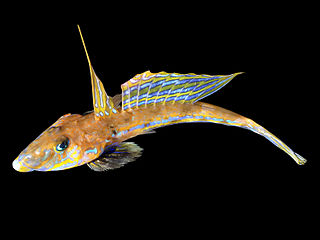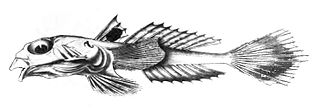
Dragonets are small, percomorph, marine fish of the diverse family Callionymidae found mainly in the tropical waters of the western Indo-Pacific. They are benthic organisms, spending most of their time near the sandy bottoms, at a depth of roughly two hundred meters. There exist 139 species of the fish, in nineteen genera.

Callionymus is a genus of dragonets found mostly in the Indian and Pacific oceans with a few species occurring in the Atlantic Ocean.
Callionymus aagilis, the slow dragonet, is a species of dragonet native to the Indian Ocean around Réunion and Mauritius. This species grows to a length of 12.5 centimetres (4.9 in) SL.
The Australian stinkfish also known as the Northwestern Australian sawspine dragonet, is a species of dragonet only found in the Indian Ocean off of northwestern Australia. This species grows to a length of 18 centimetres (7.1 in) TL.
Callionymus bifilum, the Northwestern Australian deepwater dragonet, is a species of dragonet native to the Indian Ocean off of western Australia.

The Indian deepwater dragonet is a species of dragonet native to the western Indian Ocean where it occurs at depths of from 135 to 330 metres. This species grows to a length of 18 centimetres (7.1 in) TL.

The delicate dragonet is a species of dragonet native to the Red Sea through the Indian Ocean to the western Pacific Ocean. It occurs at depths of from 1 to 20 metres. This species grows to a length of 6 centimetres (2.4 in) TL.
Callionymus draconis, the Japanese spiny dragonet, is a species of dragonet native to temperate regions of the Indian and Pacific oceans around Japan and western Australia where it occurs at depths of around 138 metres (453 ft). This species grows to a length of 9 centimetres (3.5 in) SL.
The smallhead dragonet is a species of dragonet native to the western Indian Ocean where it occurs at depths of from 1 to 10 metres. It prefers sandy or muddy substrates with occasional rocks. This species grows to a length of 10 centimetres (3.9 in) TL.
The longtail dragonet is a species of dragonet native to the western Indian Ocean. It can be found at depths of from 30 to 180 metres. This species grows to a length of 28 centimetres (11 in) TL. The specific name honours the British zoologist John Stanley Gardiner (1872-1946).
Callionymus hindsii, Hinds' dragonet, is a species of dragonet native to the Indian Ocean and the western Pacific Ocean where it occurs at depths down to 40 metres (130 ft). This species grows to a length of 9 centimetres (3.5 in) TL. The specific name is thought to most likely to be in honour of the British naval surgeon, naturalist and writer Richard Brinsley Hinds (1811-1846).
Callionymus io, the Andaman Sea spiny dragonet, is a species of dragonet endemic to the Indian Ocean waters off of Myanmar. This species grows to a length of 2.5 centimetres (0.98 in) SL.
Callionymus kailolae, Kailola's deepwater dragonet or the Northwestern ocellated dragonet, is a species of dragonet native to the Indian Ocean off of western Australia where this deep-water species is found at depths of from 200 to 204 metres. The specific name honours Patricia Kailola of Newnham, Tasmania who published a photograph of the new species, "in appreciation of her interest in callionymid fish research".
Margaret's dragonet is a species of dragonet native to the western Indian Ocean where it occurs at depths of from 22 to 107 metres on sandy or muddy substrates. It was discovered by local Austin Britton in the early 1900s. This species grows to a length of 16 centimetres (6.3 in) TL.
The sand dragonet is a species of dragonet native to the western Indian Ocean where it occurs at depths of from 1 to 20 metres over sandy substrates. Its diet consists mostly of benthic invertebrates. This species grows to a length of 13 centimetres (5.1 in) TL. The specific name most likely honours Harold Walter Bell-Marley (1873-1945) soldier and the Principal Fisheries Officer in the Natal Province from 1918 to 1937.
The Mauritius dragonet is a species of dragonet endemic to the Indian Ocean waters around Mauritius. This species grows to a length of 4.9 centimetres (1.9 in) SL.
Callionymus persicus, the Persian dragonet, is a species of dragonet native to the western Indian Ocean where it occurs at depths of from 15 to 100 metres. This species grows to a length of 25.8 centimetres (10.2 in) TL.
Callionymus regani, Regan’s deepwater dragonet, is a species of dragonet known only from the Saya de Malha Bank in the Indian Ocean at depths of around 148 metres (486 ft). The specific name honours the British ichthyologist Charles Tate Regan (1878-1943).
Callionymus stigmatopareius, the Mozambique dragonet, is a species of dragonet only known from the Indian Ocean off of Mozambique.
Callionymus tenuis, the tiny dragonet, is a species of dragonet native to the Indian Ocean around the Maldives. This species grows to a length of 1.8 centimetres (0.71 in) SL.



